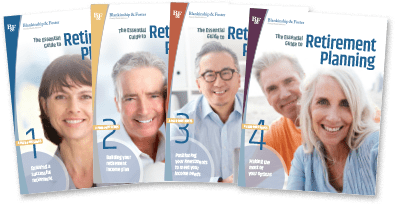read·i·ness noun 1. the state of being fully prepared for something. 2. willingness to do something.
Being ready to retire is more than just being willing to retire. Ensuring financial security for the rest of your life requires planning, discipline, and some homework. By following these 5 steps, you’ll know that you are prepared to step into retirement with confidence.
Organize your finances
Organizing your finances starts with knowing what you have and what you owe. A great tool to use is a balance sheet, which lists assets on the left side, liabilities on the right, and nets the two out to determine your net worth. Sharpen the picture by grouping your assets and liabilities into categories. This will also reveal where you can simplify by eliminating duplications and overlaps. Your categories should separate liquid assets (can be readily turned into cash and spent) from illiquid assets (your home, business, or anything else that is difficult or expensive to liquidate.)
With an organized and simplified balance sheet, you will have the clarity needed to make smart decisions.
Establish your income plan
Having an income plan is essential. Without one, you can’t assess your readiness for retirement. And until you know your readiness, you can’t start to make the adjustments and course corrections that may be required. That’s why this step should be started at least 5 years before retirement.
GUIDES
The Essential Guide to Retirement Planning
A 4-part series that answers key questions about building your plan, positioning your investments, and more.

Developing your income plan takes several steps.
- Analyze your cash flows. A basic cash flow analysis will show all your expected cash inflows and compare them to your expected outflows. First, add up all your expected income from pensions, Social Security, executive compensation and annuities. These are your cash inflows.
- Know your sustainable withdrawal rate. Calculate your withdrawal rate by dividing your total withdrawals by your liquid assets. Most retirees will have more cash outflows than inflows, and will rely on withdrawals from retirement savings to provide stable income throughout retirement. This is perfectly fine as long as the withdrawal rate is sustainable.

Next, estimate your expected cash outflows. The best way to do this is to create a retirement budget. Start with your current spending and adjust for things that will be different in retirement.
What is a sustainable withdrawal rate? This depends on your circumstances, but a general rule of thumb is the “4% Rule”, which sets the sustainable withdrawal rate at 4% of liquid assets for the first year of retirement, with inflation adjustments each year thereafter.
Plan your life beyond work
This step goes beyond the financial numbers, but it’s every bit as essential for determining whether you are ready to retire. Staying active, engaged and connected in retirement is the surest path to a healthy and enjoyable retirement. Without these, you run the risk of health issues such as depression which can also affect the people around you emotionally – your spouse, family, and friends.
When considering what your daily activities will be in retirement, consider volunteering, taking classes, starting a new hobby, traveling, joining groups or clubs, taking exercise classes or doing consulting work. All these are activities that can help maintain your sense of purpose and connectedness.
Coordinate with your spouse
If you are married, need to have buy-in from your spouse, and to consider how the change will affect your family finances. Will you both be retiring, or will your spouse work longer? If your spouse will continue working, will it mean that you are responsible for more of the household tasks? Working these things out with your spouse beforehand can really improve your quality of life and help prevent marital problems.
FAQS
We’re happy to answer any questions you have about our firm and our processes. Here are answers to some of the questions we receive most frequently.

Know your options
Your options for pensions, Social Security, health insurance, and executive benefits can really shape your financial picture. Pensions often have options for when to start collecting and how much of the benefit will be available to the survivor. Social Security claiming strategies with your spouse can also make a big difference in your retirement income over the long term.
Healthcare costs are a major expense item for many retirees, so knowing your options for health insurance can be very important. Does your or your spouse’s employer offer retiree health coverage? Or, if you or your spouse will keep working past age 65, can both of you remain on the plan?
Your next step
It’s important to start planning early so you can know that you are truly ready to retire. Using a checklist can be helpful. At Blankinship and Foster, we help you organize your finances, plan for retirement, and build your income plan. When it comes time to start transitioning to retirement, we help you implement your plan so you can successfully manage your finances throughout retirement. With our ongoing guidance, you can be free from worry about your finances, and concentrate on your new job: enjoying your retirement!

